-
current
recommendations- Liefdefjord
New page dedicated to one of Spitsbergen's most beautiful fjords. Background information and many photos.
- New Spitsbergen guidebook
The new edition of my Spitsbergen guidebook is out and available now!
- Liefdefjord
New page dedicated to one of Spitsbergen's most beautiful fjords. Background information and many photos.
Page Structure
-
Spitsbergen-News
- Select Month
- May 2025
- April 2025
- March 2025
- February 2025
- January 2025
- December 2024
- November 2024
- October 2024
- September 2024
- August 2024
- July 2024
- June 2024
- May 2024
- April 2024
- March 2024
- February 2024
- January 2024
- December 2023
- November 2023
- October 2023
- September 2023
- August 2023
- July 2023
- June 2023
- May 2023
- April 2023
- March 2023
- February 2023
- January 2023
- December 2022
- November 2022
- October 2022
- September 2022
- August 2022
- July 2022
- June 2022
- May 2022
- April 2022
- March 2022
- February 2022
- January 2022
- December 2021
- November 2021
- October 2021
- September 2021
- August 2021
- July 2021
- June 2021
- May 2021
- April 2021
- March 2021
- February 2021
- January 2021
- December 2020
- November 2020
- October 2020
- September 2020
- August 2020
- July 2020
- June 2020
- May 2020
- April 2020
- March 2020
- February 2020
- January 2020
- December 2019
- November 2019
- October 2019
- September 2019
- August 2019
- July 2019
- June 2019
- May 2019
- April 2019
- March 2019
- February 2019
- January 2019
- December 2018
- November 2018
- October 2018
- September 2018
- August 2018
- July 2018
- June 2018
- May 2018
- April 2018
- March 2018
- February 2018
- January 2018
- December 2017
- November 2017
- October 2017
- September 2017
- August 2017
- July 2017
- June 2017
- May 2017
- April 2017
- March 2017
- February 2017
- January 2017
- December 2016
- November 2016
- October 2016
- September 2016
- August 2016
- July 2016
- June 2016
- May 2016
- April 2016
- March 2016
- February 2016
- January 2016
- December 2015
- November 2015
- October 2015
- September 2015
- August 2015
- July 2015
- June 2015
- May 2015
- April 2015
- March 2015
- February 2015
- January 2015
- December 2014
- November 2014
- October 2014
- September 2014
- August 2014
- July 2014
- June 2014
- May 2014
- April 2014
- March 2014
- February 2014
- January 2014
- December 2013
- November 2013
- October 2013
- September 2013
- August 2013
- July 2013
- June 2013
- May 2013
- April 2013
- March 2013
- February 2013
- January 2013
- December 2012
- November 2012
- October 2012
- September 2012
- August 2012
- July 2012
- June 2012
- May 2012
- April 2012
- March 2012
- February 2012
- January 2012
- December 2011
- November 2011
- October 2011
- September 2011
- August 2011
- May 2011
- April 2011
- March 2011
- February 2011
- January 2011
- December 2010
- November 2010
- September 2010
- August 2010
- July 2010
- June 2010
- May 2010
- April 2010
- March 2010
- February 2010
- November 2009
- October 2009
- August 2009
- July 2009
- June 2009
- May 2009
- April 2009
- March 2009
- February 2009
- January 2009
- December 2008
- November 2008
- October 2008
- August 2008
- July 2008
- June 2008
- May 2008
- April 2008
- March 2008
- February 2008
- April 2000
- Select Month
-
weather information
-
Newsletter

| Guidebook: Spitsbergen-Svalbard |
Home →
Yearly Archives: 2018 − News & Stories
Moffen & Woodfjord – 16 September 2018
Sun
16 Sep
2018
The weather stays on our side, the sun is shining through the thin clouds and, even more important, the sea is almost flat like a mirror as we set course for Moffen in the early morning. Not too much later we are shore. Moffen! This little island just above 80 degrees north, hardly more than an extended gravel bank, it exerts a fascination that is hard to descrive with a few words. A little, lonely island in the polar sea, this almost bizarre landscape of series of old beach ridges which add up to one another to form a gravel ring around a lagoon, the charme of a forbidden island, it all comes together. Moffen is indeed a forbidden island, because you are not allowed to approach closer than 300 metres from mid May to mid September. Today it is 16 September, so you need not just the weather but also the calender on your side to get really close to the island.
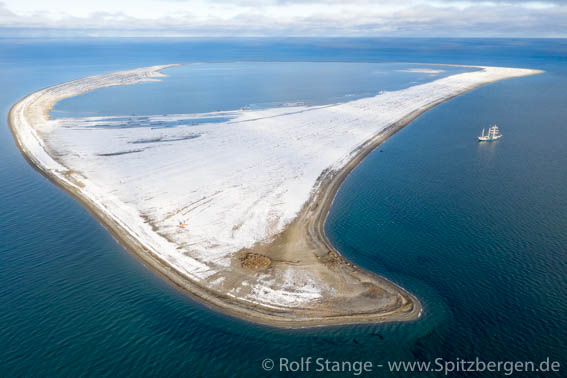
Moffen is located exactly on 80° North.
And then there are the walrusses! There are more than 100 in 3 groups on the southern tip of the island, and more in the water. We have an amazing experience with them. It is hard to tell who is more curious, again and again there are walrusses swimming towards us, curiously checking the unusual visitors out.
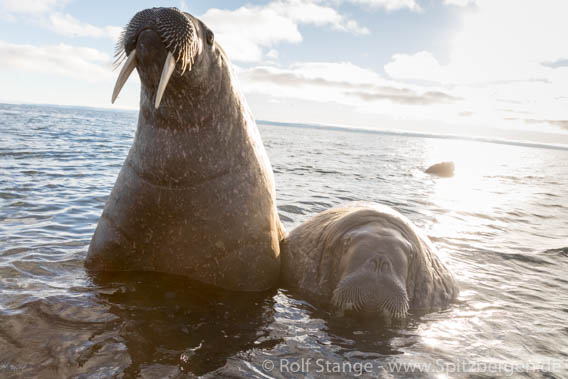
Who’s watching who? Curious walruses on Moffen.
There is also plastic on Moffen, sadly, as almost everywhere. We take quite a lot of it with us.
Many of us have read Christiane Ritter’s book „A woman in the polar night“, for some us it was a poetic door-opener to the Arctic many years ago. We do have the chance to visit the hut near Gråhuken where the famous wintering took place. An almost emotional experience for some of us, and certainly interesting for everybody.
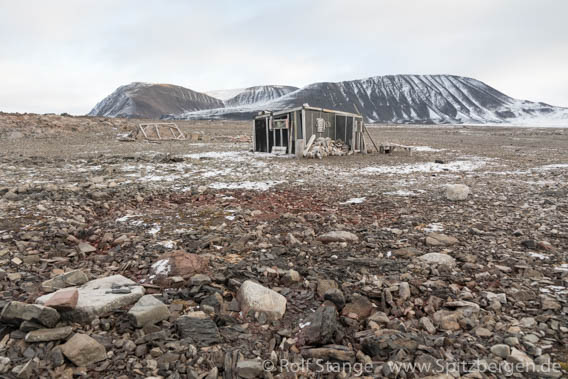
Christiane Ritter wintered in the Ritter hut in 1943/35. The hut was built in 1928 by the legendary Norwegian trapper Hilmar Nøis.
Finally we drop anchor in the bay of Mushamna – the lagoon itself is frozen, so we stay outside as we are not sure if provisions would last for a winter. We spend the evening around a fire on the beach, watching how the colours in the landscape change.

Murchisonfjord & Sorgfjord – 15 September 2018
Sat
15 Sep
2018
There must have been hundreds of Russian crosses in Spitsbergen centuries ago, built by the Pomors near their hunting stations. Nowadays there are only two of them left and still standing, both on little islands in Murchisonfjord. One of them is our destination for the morning.
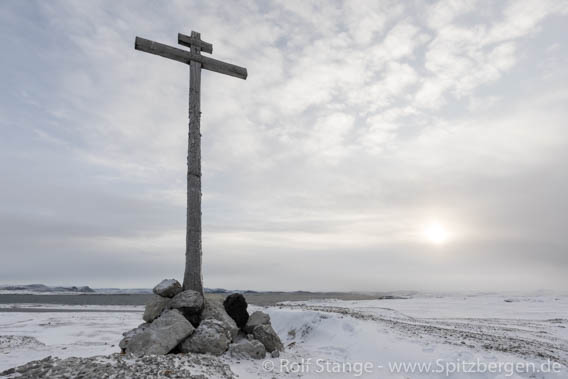
Russian cross, Nordre Russeøya/ Murchisonfjord
Snow is lying on the ground and there is the smell of winter in the air, a feeling even enhanced by the yellowish light of the low sun. We take stunning arctic winter impressions and some large fishing nets back on board after the landing.
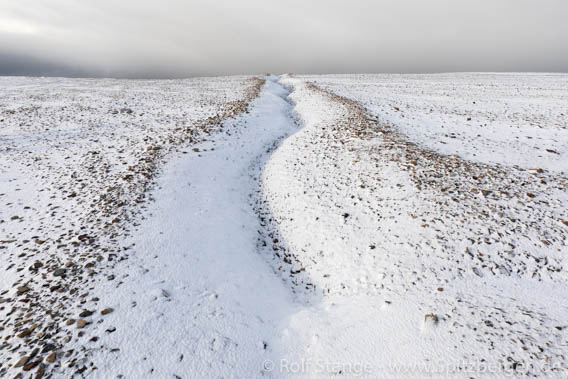
In Sorgfjord, the clouds have disappeared almost completely, the sun is low on the blue sky. The snow-covered land is shining in colours somewhere between white, blue and red.
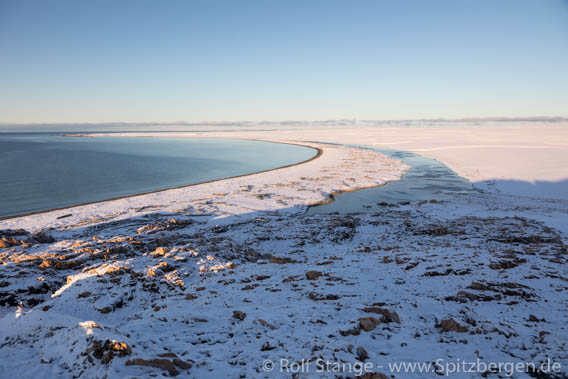
Crozierpynten on the Eastern side of Sorgfjord
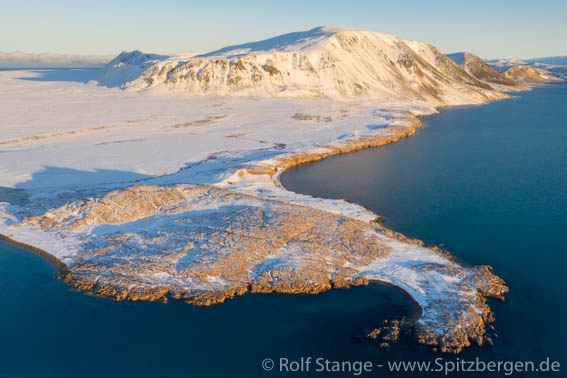
Murchisonfjord – 14 September 2018
Fri
14 Sep
2018
A reasonably calm night under sail brings uns far east to Nordaustland, as far as Murchisonfjord. A thin layer of fresh snow is a clear sign of the summer fighting a lost battle in these latitudes, the thermometre does hardly climb above zero anymore. A snow shower was reducing the visibility almost to zero as soon as we went ashore.
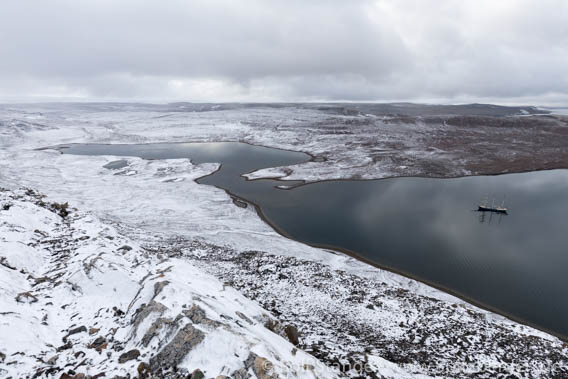
Snaddvika, Murchisonfjord
We landed in the innermost corner of Murchisonfjord. White snow was covering red rocks, greetings from early chapters of Earth history. Wide-open views over hills and valleys, fjords and islands, with the ice cap in the background.
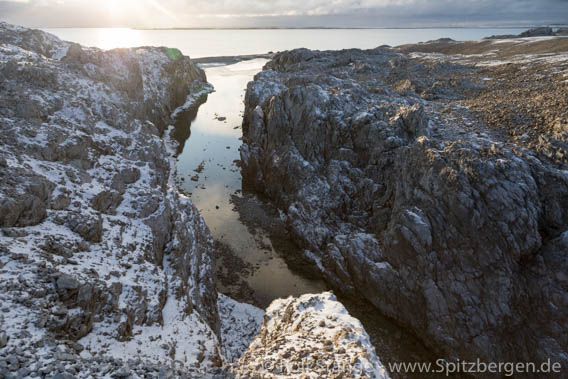
Kinnvika, Murchisonfjord
We move over to Kinnvika for the afternoon landing. The September sun is casting warm light over the cold landscape and the old Swedish research setation. The light is getting more and more intensive, with colours like from an dream.
We spend the night at anchor in Kinnvika, nice and calm.

The Swedish research station Kinnvika was last in operation in 2007/2008.
From Smeerenburg to Hamiltonbukta – 13 September 2018
Thu
13 Sep
2018
A lovely bit of sailing takes us up to Smeerenburgfjord during the night. Smeerenburg gives us a friendly welcome with fine landing conditions. Walrusses, Dutch 17th century whaling, polar foxes and the beautiful scenery make the morning.
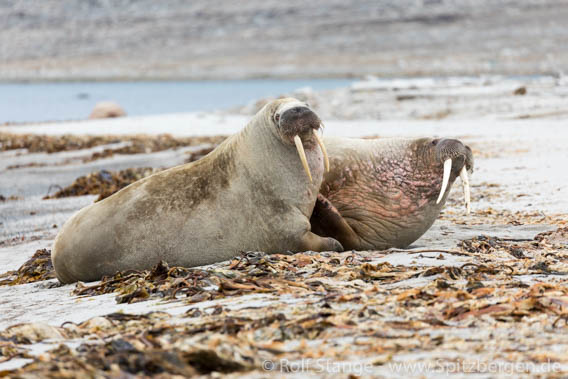
Walrusses, Smeerenburg
As we continue further eastwards, we see the first polar bear of the trip. Quite distant, but well visible for everybody.

The first polar bear of our trip!
In Hamiltonbukta, we enjoy the timeless beauty and silence of the Arctic for a while, surrounded by stunning mountains and glaciers. So, another good day in the Arctic! We are curious what tomorrow may bring, as we set course to the northeast.

Smeerenburg
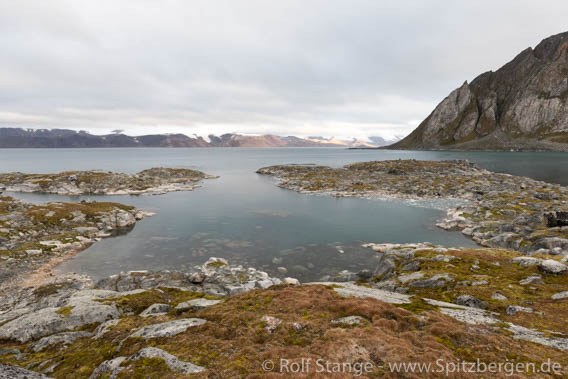
Hamiltonbukta
Kongsfjord – 12 September 2018
Wed
12 Sep
2018
We start in rather traditional manner in Ny-Ålesund in Kongsfjorden. Our first and last visit to a settlement. Spitsbergen gives us a warm – well, chilly, but sunny and beautiful – welcome. A fresh breeze is coming towards us as we go alongside. We dedicate the morning to the little settlement with its history, coal mining and north pole expeditions, and the present: science.
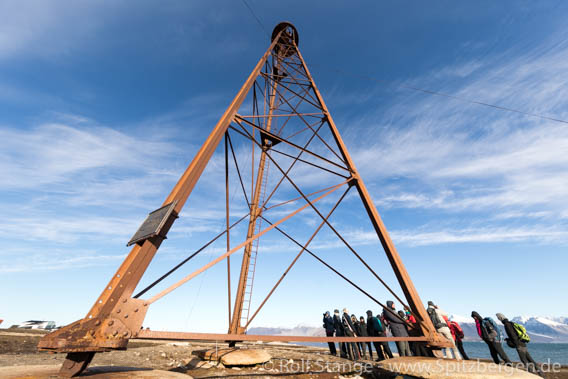
The mast from which Amundsen and Nobile launched their airships.
The large glacier Kronebreen is tempting us in the afternoon. We can’t resist – well, why should we even try – and enjoy the stunning landscape.
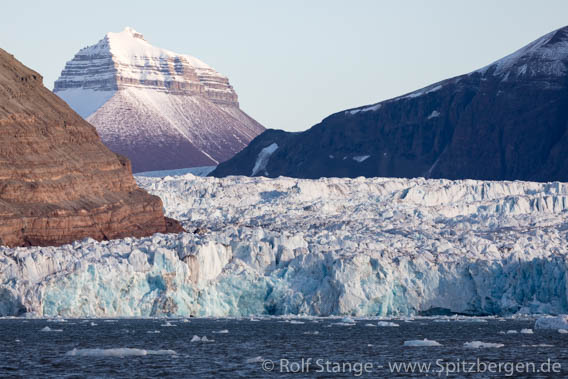
The mighty glacier Kronebreen
Later, we set sails again. It is pure pleasure to move silently out of Kongsfjorden and into the sunset.

Text: Rolf Stange
Isfjord – 11 September 2018
Tue
11 Sep
2018
It was high time to take off again, to get water under the keel and wind around the masts! We got a good bit of both as we went on board SV Antigua today. There was a fair breeze blowing out of Adventdalen, the sun was shining from a blue sky. Late afternoon, we left the small pier in Longyearbyen, and up went the sails!
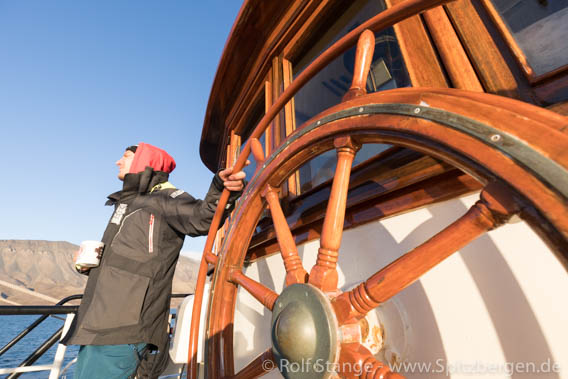
Up went the sails! This time towards the west and north coast of Spitsbergen.
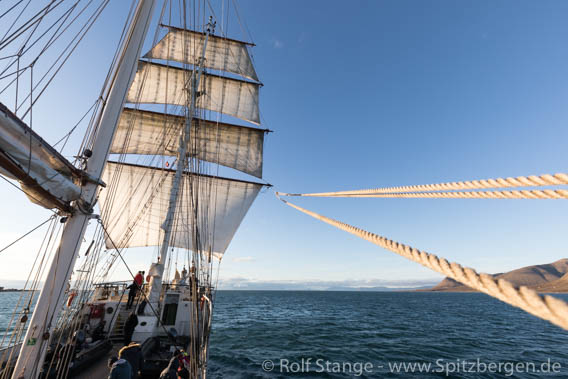
From Adventdalen into the Isfjord.
It was a beautiful bit of real sailing out of Adventfjord and through most of Isfjord. Many people on board have been on Spitsbergen a number of times before, so it should really be a very interesting trip!
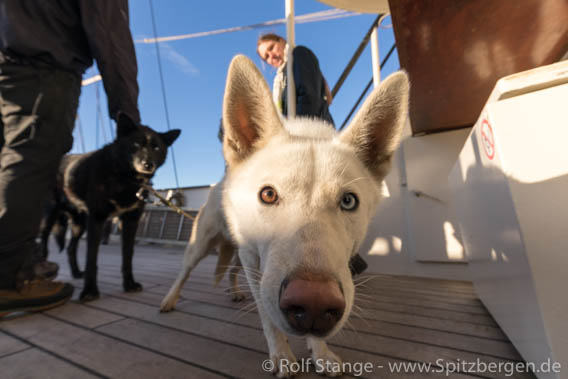
Great guests and atmosphere on board!
The first evening made clear what September in Spitsbergen is all about: warm light from the low sun, stunning scenery and even a Blue whale which waved with its fluke.

A Blue whale, the biggest animal on earth…
We passed the wide plateau of Fuglefjella, Grumantbyen, Colesbukta. Mountains and glaciers on the other side in the north, Alkefjellet under the bright sun ahead of us. Amazing beauty wherever you looked!
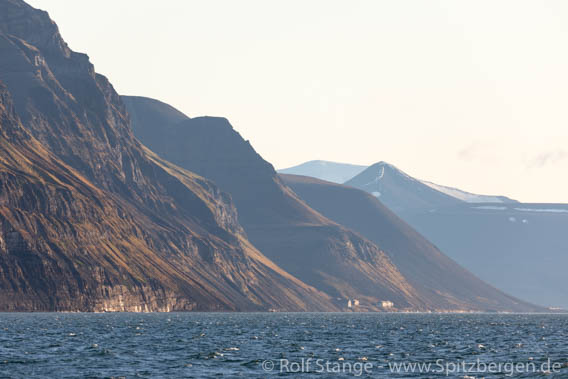
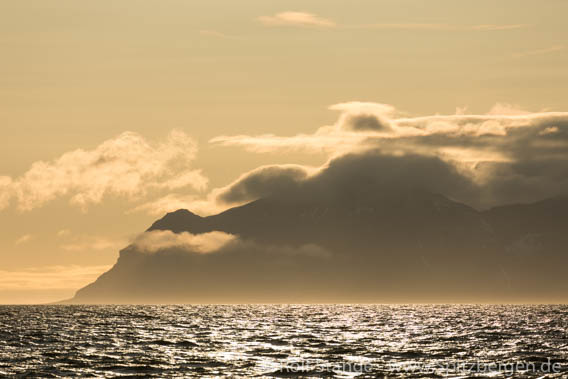

Polar bear family in Bjørndalen near Longyearbyen
Today (Monday, 10 September), a polar bear family was seen near Vestpynten, not far from the airport and campsite at Longyearbyen. It was a female bear with two first-year cubs, probably the same polar bears that were seen on Saturday at Revneset, on the north side of Adventfjord opposite of Longyearbyen. On Saturday, the bears were chased away by helicopter towards Sassenfjord, away rom Longyearbyen.
Polar bears including females with cubs regularly cover large distances. A walk including longer swimming distances from Adventfjord (Longyearbyen) to Sassenfjord and back within 2 days is fully realistic and normal.
When the bears were seen near Vestpynten today around 16.00, both curious onlookers and the Sysselmannen (police) were soon on the scene, as reported by Svalbardposten. The Sysselmannen followed the polar bear family by car slowly towards Bjørndalen further west.
There, hopes that the bears might continue and disappear from the Longyearbyen area soon vanished in the haze, as the bears were seen feeding on a large whale carcass, possibly from a sperm whale as appears on a photo taken by the Sysselmannen. This might provide the bears in question with food for a longer period, if the whale does not start to float and drift away again. Chances are also that the whale carcass attracts further bears.
The Sysselmannen asks the public not to get close to the bears and to be alert and to exercise usual safety measures at any time in the field.
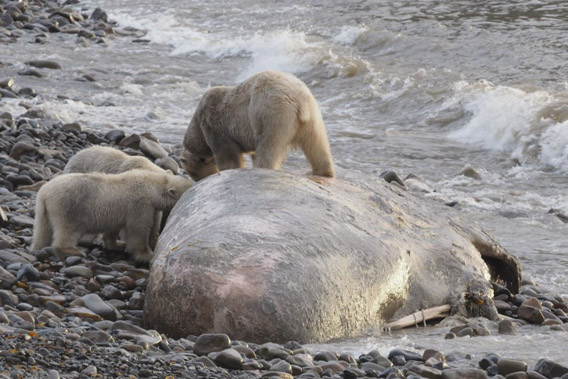
Polar bear family with a solid meal in Bjørndalen near Longyearbyen, Monday (10 September) afternoon. Photo © Sysselmannen.
Update: the polar bears were scared away from the whale carcass by the Sysselmannen later on Monday, as Svalbardposten wrote. The dead whale was towed into the fjord by Polarsyssel, the Sysselmannen’s ship, and the bears were scared and moved up into Bjørndalen.
The Spitsbergen-Calendar 2019 is available
Our already almost traditional Spitsbergen-calender ist now available for 2019. It is available as before in the bigger A3 format (beautiful on the wall) and the smaller A5 (great for example on the table or on the wall where not so much space is available).

With arctic impressions through the year: the new calendar Spitsbergen 2019 is now available.
As opposed to other offers available on the market, we select a set of 12 entirely new photos every year to create a completely new calendar with fresh impressions, showing some of Spitsbergen’s most beautiful sides including scenery, wildlife and flowers.
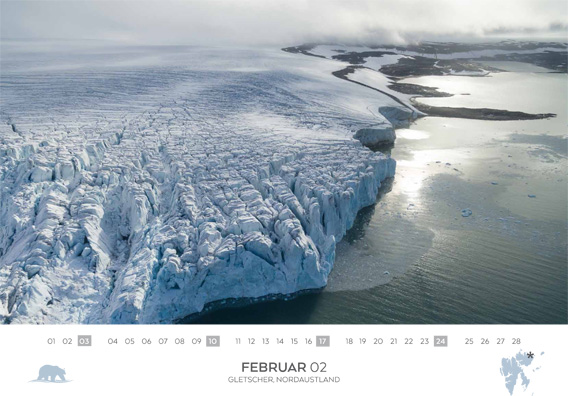
Unusual perspective of an impressive landscape: the ice cap Austfonna seen from the air.
Unusual perspectives of remote places together with stunning wildlife photos form a good part of the selection, which is completed by flowers and stunning scenery of polar landscapes and ice.

Of course there are some polar bears in the calendar 🙂
Click here to see all images of the Spitsbergn calender 2019, more information and ordering.
Job market in Longyearbyen growing in spite of reduction in coal mining
The great fear of a collapse of the job market in Longyearbyen after the significant reduction of coal mining, especially in Sveagruva, did not become reality so far. This is indicated by the latest statistics of the Statistik Sentralbyrå, the Norwegian directory of statistics. In 2017, there were 4.2 % more jobs in Svalbard compared to 2016. The number of jobs in mining were actually reduced by 34 % down to 100, but this loss was more than compensated by growth in other branches, mostly in relation to tourism. Hotels and restaurants created 36.3 % more jobs in 2017 than in 2016, totalling 315 jobs in 2015. ´
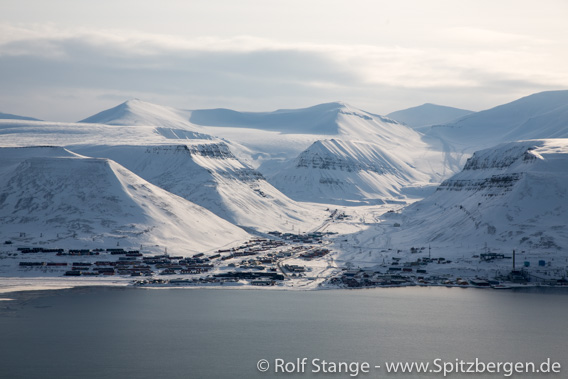
Longyearbyen is growing, also on the job market: 4,2 % more jobs in 2017.
This growth is measured in “Årsverk”, which may be best translated with “man hours per year”. 315 “årsverk” do not necessarily mean 315 full-time employees, but an amount of paid work that could be done by 315 people within one year. This amount of work may, however, be spread over a larger number of part-time or seasonal jobs, which is certainly the case to some degree in tourism. “Tourism” as such is not a category in the statistics. Jobs created within tourism are measured in categories such as hotels & restaurants, service industry and transport and logistics.
Guidebook “Spitzbergen-Svalbard”: next edition soon available
The first edition of my guidebook Spitzbergen-Svalbard came out in German in 2007, followed by the first Englisch edition Spitsbergen-Svalbard in 2008 and the first Norwegian edition Svalbard – Norge nærmest Nordpolen in 2017. The German version soon became popular amongst Spitsbergen-travellers and enthusiasts, so I could develop the book through several editions. The 5th German edition came out in 2015 and it is now out of print, the new (6th) edition of the German version is currently in print and expected to be available in September 2018. I have updated the book comprehensively, both the text and the index have been improved and enlarged so the new edition will have 580 pages (the old edition has 560 pages). Maps and fonts have been improved. My knowledge and experience keep growing also after more than 20 years of learning and living the Arctic in theory and real life and all this becomes part of updated editions, and so does new relevant legislation, recent developments in Longyearbyen and so on and so forth.
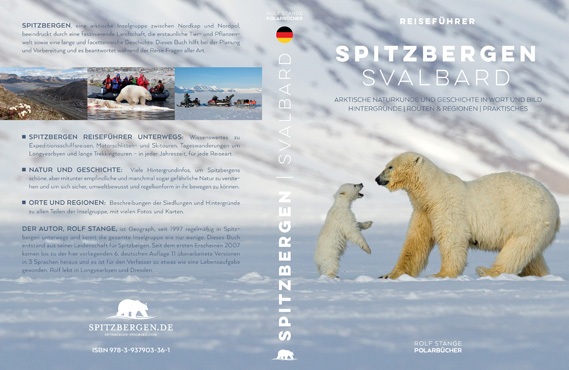
The newest German edition of the guidebook Spitzbergen-Svalbard is in print and due to be released in September 2018.
Many professional guide colleagues use this book (including its English and Norwegian versions) on a daily basis in their arctic lives, referring to it as the “Svalbard bible” (or Spitsbergen bible, whatever you prefer)! A compliment that I as the author am happy to accept.
The English version Spitsbergen-Svalbard has been updated thoroughly in early 2018, and the same goes for the Norwegian version Svalbard – Norge nærmest Nordpolen which came out in 2017.
All three versions of the guidebook can be ordered on this website including the German version. If you order the German version, you will get the new, 6th edition as soon as it is available (expected in September 2018).
Bed available in ladies cabin on Antigua (11-21 September 2018)
Spitsbergen under sail with SV Antigua, 11 intense days – a dream journey for friends of the Arctic at a time when sunsets have started to bring amazing colours to these high latitudes again. Now there is the opportunity to join on a short notice – there is a vacancy in a ladies cabin. Click here to read more about this trip. This trip will be German speaking, so the description is also in German.
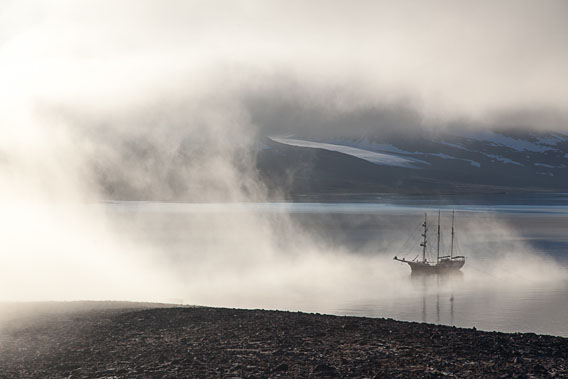
Spitsbergen under sail with SV Antigua in September 2018: Space available in a ladies cabin.
So – go ahead and welcome on board!
Just get in touch with Rolf Stange (contact) for any questions regarding the trip, the ship, Spitsbergen … or get in touch directly with the Geographische Reisegesellschaft for reservations and booking.
Again, negative records from the arctic: ice cover low, temperatures high
It comes hardly as a surprise: once again, there are negative records of the current sea ice situations. As the Norwegian Ice Service released on Twitter, there has never been as little ice around Svalbard as currently since beginning of the recordings in 1967. As the latest ice chart shows, both Svalbard and neighbouring Frans Josef Land are completely free of sea ice:

Ice chart of 22 August 2018 (by MET Norway).
According to the Norwegian Ice Service, the sea ice cover in the Svalbard area was 123,065 square kilometres, which is 105,139 square kilometres less compared to the long-term average (1981-2010), a loss of almost 50 %!
But scientists are even more worried about the loss of ice north of Greenland, which is also visible in the ice chart above. Northernmost Greenland is an area where ice is pushed against the coast by currents, so it is – was – building up a very solid ice cover averaging 4 m in thickness and reaching more than 20 m thickness in places! This ice cover was, however, weakened by warm air incursions such as the extreme event in February. The weakened ice could be moved around by wind much more easily, and this is exactly what happened now in a large area north of Greenland. Even if the water surface freezes again soon, the damage is now done and it is hardly reversible: as the term multi-year ice suggests, it takes many years to replace a lost area of such ice, but it is hardly expected that this will happen at all given current climate developments.
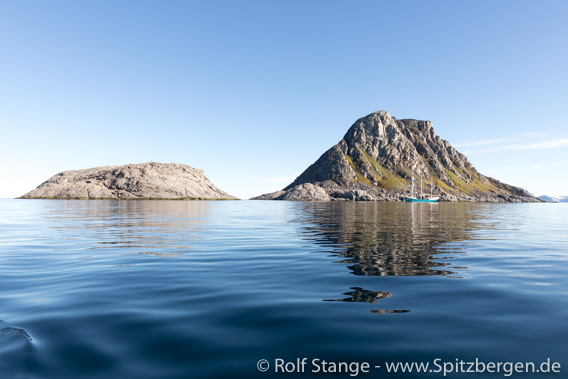
Svalbard furthest north: Rossøya (left) and Vesle Tavleøya completely ice-free, mid-July 2018.
It fits into this picture that Longyearbyen has now got an unbroken series of 90 (!) months with temperatures above the long-term average. A dramatic development, but hardly a surprise.
Isøyane & Kapp Borthen – 16 August 2018
Thu
16 Aug
2018
Sørkapp turned out to be a piece of cake this time 🙂 hardly any sea worth mentioning. We still went up the west coast a good couple of miles last night, to place us a bit further north, so we can make it up to Isfjord without troubles when the time comes. Soon. As it remained calm, we dropped the anchor late night or, rather, early morning near Isøyane off Torellbreane. Amazing scenery!

All the way back since I started thinking, I wanted to go to Isøyane, and today was the day. A little walk on an island less than one kilometre in diameter, without any real elevations, was exactly the right thing for us today. The near-shore waters are very shallow and rocky, making landing a bit challening, but we found the one and only right spot. What can I say – a wonderful little island! This green, lush tundra gives you an idea of the countless generations of Common eider ducks, geese, Arctic terns, various skuas and other feathered creatures have fertilised the tundra here year after year. The fresh green was a pleasure for the eye, after so many days in the polar desert and glacier environments further east and north! The coastal landscape was stunning, with its many little bays and extensive marine platforms cut by wave action into solid rock.
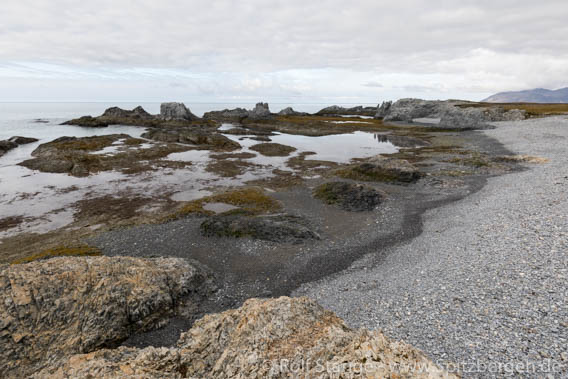
Kapp Borthen is not far from Isøyane. Another place from which you will usually keep a good distance. Only on a really good day, when the weather is fine and stable and the sea is calm, it is a place where you may land. There is a wide plain between the coast and the mountains, so flat that you could almost land an aeroplane here. And this is exactly what the crew of a German fighter plane did in September 1942 after their plane had been damaged during an attack on a convoi.
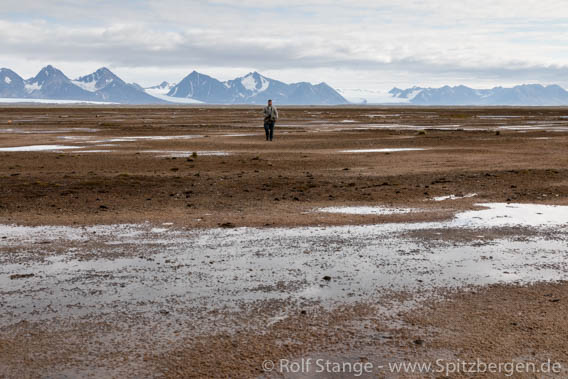
We are now cruising north towards Isfjord. Calm seas and sunny at times. Soon our track will be a circle.
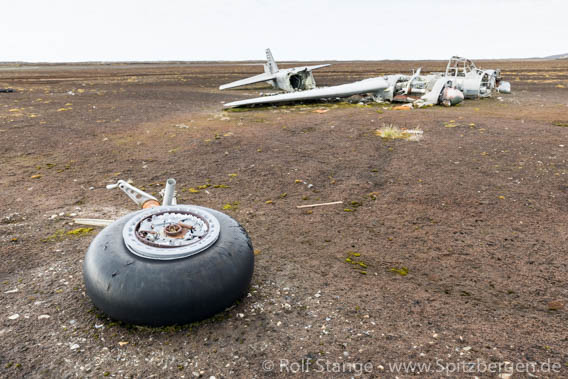
Isbukta – 15 August 2018
Wed
15 Aug
2018
We anchored in Isbukta to get at least a few hours of sleep before it would be time to round Sørkapp (the south cape, Spitsbergen’s little version of Cape Hoorn). As the sun was shining and conditions were ideal in the morning, of course we took the opportunity to to out for a hike. A dead Beluga washed up on shore made us a bit suspicious – who knew what might be sleeping behind a hill, considering to defend this titbit in forward gear if necessary? But as it turned out on careful inspection, there had not yet been anything with big teeth working on the carcass, which had obviously been there for a while already. A carefull check of the area including aerial reconnaissance indicated that the area was safe at the time being. You can never be 100 % certain, but we could certainly venture out with good conscience. Isbukta is stunningly beautiful with its large glaciers and many rugged mountains, like a smaller version of Hornsund. And that under a blue, sunny sky from an elevated position!

It was actually quite windy up there, so we were a bit curious what rounding Sørkapp would bring. The forecast was not bad at all, and we are at our southernmost position now at the time of writing, getting up to the west coast of Spitsbergen soon. So far it is really quite ok.
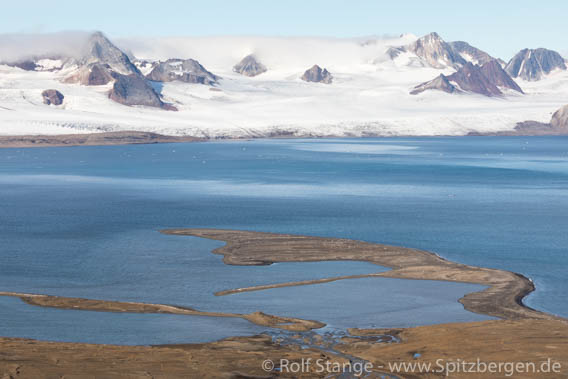
The east coast – 14 August 2018
Tue
14 Aug
2018
Spitsbergen’s east coast has, for good (or bad) reasons, a reputation of a certain inaccessibility, if you exclude Sabine Land with Agardhbukta, Dunérbukta and Mohnbukta, which can be reached relatively easily from Longyearbyen, especially in winter. But elsewhere it is difficult. Over land, it would require a long and very demanding, expedition-style trip, and from the sea, this rugged, uncharted coastline is not exactly inviting either.
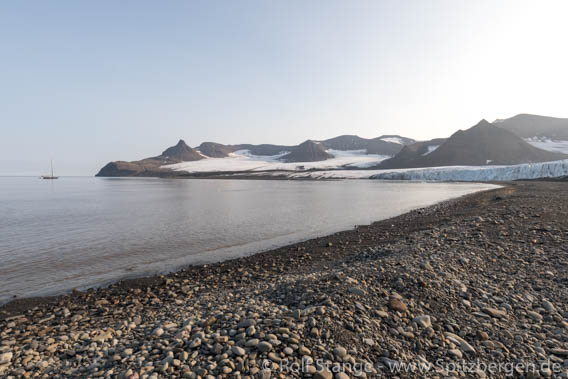
Some wind had come up in Agardhbukta over night, no thought of any landing here now. Also further south, it did not really look promising, initially. It was not until we had almost reached Hambergbukta that we had ideal conditions to approach one of the many glaciers in that area. As it turned out, it had retreated a bit and exposed a shoreline composed of former moraine that now forms several lagoons, where a landing was easily possible, at least on a perfectly calm day like this! Completely young, fresh land, very virgin. I was wondering if anyone had ever set foot on this place before, which not too many years ago was still glacier-covered? Of course I don’t really know and one should be rather careful before actually claiming to be the first one anywhere in Spitsbergen. But at least the fact that the thought seems possible and actually quite reasonable is pretty amazing and rather attractive!
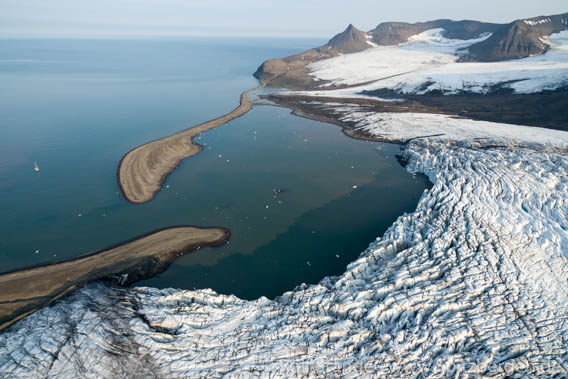
The glacier must actually have advanced a bit again quite recently, as it has pushed up a steep little moraine ridge, which had some pieces of young driftwood built in. Some of us got their crampons out to venture on a little glacier hike, exploring crevasses and whatever else one can find on a glacier. Some others went for a silent, little beach walk, going to one lagoon and then to the other and enjoying all the little and big things that you can find in nature in a plce like this. Discovering a new place, somewhere wild and remote, especially on the east coast of Spitsbergen, how good can life be? 🙂
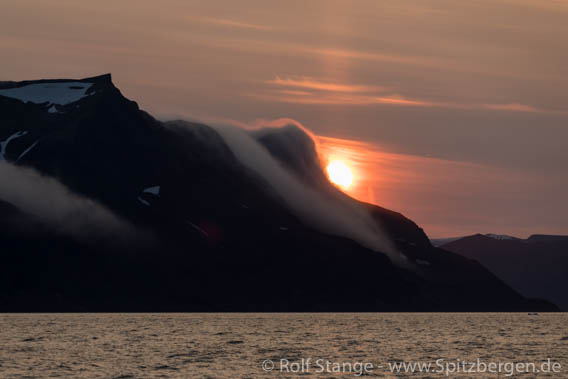
Later, the sun delighted us with another beautiful, very red nearby-sunset.
News-Listing live generated at 2025/May/10 at 02:13:56 Uhr (GMT+1)




























